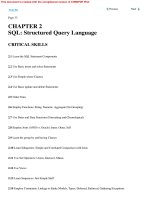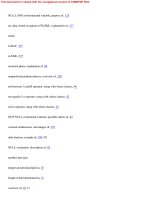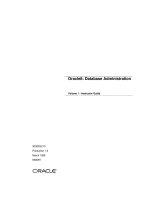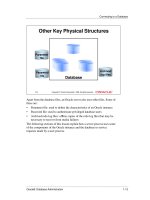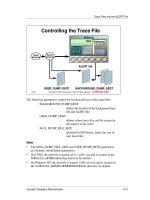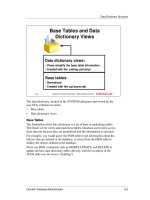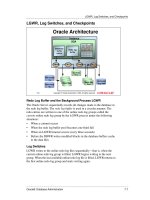Oracle 8 Database Administration volume 2 instruction guide phần 9 ppsx
Bạn đang xem bản rút gọn của tài liệu. Xem và tải ngay bản đầy đủ của tài liệu tại đây (152.42 KB, 34 trang )
Oracle8: Database Administration 20-29
.
Summary
Quick Reference
Context Reference
Initialization parameters None
Dynamic performance views None
Data dictionary views DBA_ROLES
DBA_ROLE_PRIVS
DBA_SYS_PRIVS
ROLE_ROLE_PRIVS
ROLE_SYS_PRIVS
ROLE_TAB_PRIVS
SESSION_ROLES
Commands CREATE_ROLE
ALTER ROLE
DROP ROLE
SET ROLE
ALTER USER DEFAULT ROLES
GRANT
REVOKE
Packaged procedures and functions DBMS_SESSION.SET_ROLE
20-30 Oracle8: Database Administration
.
Lesson 20: Managing Roles
21
Auditing
21-2 Oracle8: Database Administration
.
Lesson 21: Auditing
Instructor Note
Topic Timing
Lecture 30 minutes
Practice 0 minutes
Total 30 minutes
Oracle8: Database Administration 21-3
.
Objectives
Objectives
21-2
Copyright Oracle Corporation, 1998. All rights reserved.
Session Objectives
• Differentiating between database
auditing and value-based auditing
• Using database auditing
• Viewing enabled auditing options
• Retrieving and maintaining
auditing information
21-4 Oracle8: Database Administration
.
Lesson 21: Auditing
Overview
Auditing of Privileged Operations
The Oracle server will always audit the following database related actions
into the system audit trail:
• Instance startup: An audit record is generated that details the OS user
starting the instance, terminal identifier, the date and time stamp, and
whether database auditing was enabled or disabled.
• Instance shutdown: An audit record is generated that details the OS user
shutting down the instance, terminal identifier, the date and time stamp.
• Connections to the database with administrator privileges: An audit
record is generated that details the OS user connecting to Oracle as
SYSOPER or SYSDBA, to provide accountability of users with
administrator privileges.
Database Auditing
Database auditing is the monitoring and recording of selected user database
actions. Information about the event is stored in the audit trail.
21-3
Copyright Oracle Corporation, 1998. All rights reserved.
Auditing Categories
• Auditing privileged operations
– Always audited
– Startup, shutdown, and SYSDBA connections
• Database auditing
– Enabled by DBA
– Cannot record column values
• Value-based or application auditing
– Implemented through code
– Can record column values
– Used to track changes to tables
Oracle8: Database Administration 21-5
.
Overview
The audit trail can be used to investigate suspicious activity. For example, if
an unauthorized user is deleting data from tables, the database administrator
may decide to audit all connections to the database in conjunction with
successful and unsuccessful deletions of rows from tables in the database.
Auditing might also be used to monitor and gather data about specific
database activities. For example, the database administrator can gather
statistics about which tables are being updated, how many logical I/Os are
performed, and how many concurrent users connect at peak times.
Value-Based Auditing
Database auditing cannot record column values. If the changes to database
columns need to be tracked and column values need to be stored for each
change, use application auditing. Application auditing can be done either
through client code, stored procedures, or database triggers.
Instructor Note
Demonstrate auditing the Windows NT audit trail:
1 Connect as SYSDBA.
2 Start—>Programs—>Administrative Tools—>Event Viewer.
3 From the Event Viewer menu, select Log—>Application. (Application is
the type of log record that Oracle creates in NT). The Event Viewer will
show the list of application auditing events.
4 To display the last Oracle event, double-click on the first event with a
source of Oracle80.orcl.
Since startups, shutdowns, and connect internals are always audited, you
will see these events, even if auditing is not enabled in the parameter file.
Also show the audit files in AUDIT_FILE_DEST on UNIX.
21-6 Oracle8: Database Administration
.
Lesson 21: Auditing
Value-Based Auditing Using Triggers: An Example
The slide shows an example of a script that can be used to create a trigger to
perform value-based auditing. This trigger stores the old and new column
values, the name of the user making the change, and the time stamp
whenever changes are made to the employee table.
Database auditing is a database administrator task, and, therefore, is the
main focus of this lesson.
21-4
Copyright Oracle Corporation, 1998. All rights reserved.
CREATE TRIGGER scott.audit_employee
AFTER INSERT OR DELETE OR UPDATE
ON scott.emp
FOR EACH ROW
BEGIN
INSERT INTO scott.audit_employee
VALUES ( :OLD.empno, :OLD.name,…,
:NEW.empno, :NEW.name,…,
USER, SYSDATE);
END;
Value-Based Auditing:
An Example
Oracle8: Database Administration 21-7
.
Using Database Auditing
Using Database Auditing
The database administrator requires a clearly defined purpose for auditing. If
not, the amount of auditing information generated may cause the audit trail
to grow uncontrollably with insignificant information.
Enable Database Auditing
Once you have decided what to audit, you set the AUDIT_TRAIL
initialization parameter to enable auditing for the instance. This parameter
indicates whether the audit trail is written to a database table or the operating
system audit trail.
Specify Audit Options
Next, you set specific auditing options using the AUDIT command. With the
AUDIT command, you indicate which commands, users, objects, or
privileges to audit. You can also indicate whether an audit record should be
generated for each occurrence or once per session. If an auditing option is no
longer required, you can turn off the option with the NOAUDIT command.
21-5
Copyright Oracle Corporation, 1998. All rights reserved.
Database Auditing
Audit trail
Audit options
Other tables
Parameter file
Enable DB auditing
DBA
Specify
audit options
Database
User
Execute command
Generate
audit trail
Review audit
information
Server
process
21-8 Oracle8: Database Administration
.
Lesson 21: Auditing
Execution of Statements
When users execute PL/SQL and SQL statements, the server process
examines the auditing options to determine if the statement being executed
should generate an audit record. SQL statements inside PL/SQL program
units are individually audited, as necessary, when the program unit is
executed. Because views and procedures may refer to other database objects,
several audit records may be generated as the result of executing a single
statement.
Generating Audit Data
The generation and insertion of an audit trail record is independent of a
user’s transaction; therefore, if a user’s transaction is rolled back, the audit
trail record remains intact. Since the audit record is generated during the
execute phase, a syntax error, which occurs during the parse phase, will not
cause an audit trail record to be generated.
Reviewing Audit Information
Examine the information generated during auditing by selecting from the
audit trail data dictionary views or by using an operating system utility to
view the operating system audit trail. This information is used to investigate
suspicious activity and to monitor database activity.
Oracle8: Database Administration 21-9
.
Using Database Auditing
The database administrator sets the AUDIT_TRAIL initialization parameter
to enable auditing in the instance.
Syntax
AUDIT_TRAIL = value
where: value can be one of the following:
DB enables auditing and directs all audit
recordstothedatabaseaudittrail(sys.aud$)
OS enables auditing and directs all audit
records to the operating system audit trail
(if permitted on the operating system)
NONE disables auditing(Thisisthedefaultvalue.)
Audit records will not be written to the audit trail unless the DBA has set the
AUDIT_TRAIL parameter to DB or OS. Although the SQL statements
AUDIT and NOAUDIT can be used at any time, records will only be written
to the audit trail if the DBA has set the AUDIT_TRAIL parameter in the
initialization file.
Instructor Note
This slide has builds. There are five stages.
21-6
Copyright Oracle Corporation, 1998. All rights reserved.
Enabling Database Auditing
AUDIT_TRAIL
Parameter
file
DBA
NONE
No trail
AUD$
table
DB
OS audit
trail
OS
OS
Instance
21-10 Oracle8: Database Administration
.
Lesson 21: Auditing
Note
• For backward compatibility, AUDIT_TRAIL can also be set to TRUE
(equivalent to DB) or FALSE (equivalent to NONE).
• The Installation and Configuration Guide provides information on
writing audit records to the OS audit trail.
UNIX: Operating System Audit Trail
Most UNIX systems do not support writing the audit information to the
operating system audit trail. On these operating systems, setting
AUDIT_TRAIL=OS generates text files in the directory specified by the
initialization parameter, AUDIT_FILE_DEST. This parameter is set to
$ORACLE_HOME/rdbms/audit by default.
Windows NT: Operating System Audit Trail
Windows NT permits the operating system audit trail to register Oracle audit
information. These entries can be reviewed using the Event Viewer.
Oracle8: Database Administration 21-11
.
Using Database Auditing
Events Audited on Request
You can specify the auditing options using the AUDIT command. These
audit records are never generated by sessions established by the user SYS or
connections as INTERNAL. Connections by these users bypass certain
internal features of Oracle to enable administrative operations to occur such
as database startup, shutdown, and recovery.
Statement Auditing
You can audit by using a type of SQL statement or by a type of object. The
statement auditing example audits all CREATE, ALTER, and DROP USER
statements for all users.
Statement auditing options are typically broad, auditing the use of several
types of related actions per option. For example, AUDIT TABLE tracks
several DDL statements regardless of the table on which they are issued.
You can set statement auditing to audit selected users or every user in the
database.
21-7
Copyright Oracle Corporation, 1998. All rights reserved.
Enabling Auditing Options
• Statement auditing
• Privilege auditing
• Schema object auditing
AUDIT select any table
BY scott BY ACCESS;
AUDIT user;
AUDIT LOCK ON scott.emp
BY ACCESS WHENEVER SUCCESSFUL;
21-12 Oracle8: Database Administration
.
Lesson 21: Auditing
Privilege Auditing
Privilege auditing audits the use of system privileges. In the example,
whenever SCOTT uses the SELECT ANY TABLE privilege, an audit entry
is generated; an entry will only be generated if SCOTT queries tables
belonging to other users, for which he has not received SELECT privilege.
When auditing, owner privileges are checked first, then object privileges,
and then system privileges. So if a user’s SELECT ANY TABLE privilege is
being audited, and he selects from a table he owns, then the SELECT ANY
TABLE privilege would not cause an audit record to be generated, because
the user can SELECT from the table using his ownership privilege.
Schema Object Auditing
Schema object auditing audits statements performed on a specific schema
object. In the example, an audit trail entry is generated when a user
successfully executes the LOCK command on the object SCOTT.EMP.
Syntax
Use the following command to enable auditing options:
Privilege or Statement Auditing
AUDIT {statement|system_priv}
[, {statement|system_priv} ]
[BY user [, user ] ]
[BY {SESSION|ACCESS} ]
[WHENEVER [NOT] SUCCESSFUL]
Object Auditing
AUDIT statement [, statement ]
ON {[schema.]object|DEFAULT}
[BY {
SESSION|ACCESS}]
[WHENEVER [NOT] SUCCESSFUL]
where: statement specifies the SQL statement type or
schema-object to audit
system_priv specifies the system privilege to audit
schema.schema-object identifies the object chosen for auditing
DEFAULT sets the specified object options as
default object options for subsequently
created objects
Oracle8: Database Administration 21-13
.
Using Database Auditing
user indicates to only audit the users in the list
(If this clause is omitted, then all users’
activities are audited.)
BY SESSION causes Oracle to insert only one record per
database object into the audit trail for each
session, no matter how many SQL
statements of the same type are submitted
(This is the default, except for DDL.)
BY ACCESS causes Oracle to insert a record into the
audit trail each time an auditedstatementis
submitted (For Data Definition Language
(DDL) statements,Oraclealwaysauditsby
access.)
WHENEVER specifies that auditing is to be carried out
only on successful or unsuccessful
completionofSQLstatements(Thedefault
is both.)
Note
• Since audit records are generated during the execution phase, parse
errors, such as TABLE OR VIEW DOES NOT EXIST, cannot be
trapped by using WHENEVER UNSUCCESSFUL clause.
• Statement and privilege auditing options specified by the AUDIT
command apply only to subsequent sessions, not to the current session.
In contrast, changes to schema object, audit options become effective for
current sessions immediately.
Instructor Note
There are no OEM screens for auditing.
21-14 Oracle8: Database Administration
.
Lesson 21: Auditing
Schema object auditing selectively audits statements executed against
specified schema objects. The ALL shortcut can be used as a schema object
auditing option to audit all options applicable for the type of object.
You can audit statements that reference tables, views, sequences, standalone
stored procedures and functions, packages, snapshots, libraries, and
directories. Procedures in packages cannot be audited individually. The table
shows the available audit options by object type.
Statements that reference clusters, database links, indexes, or synonyms are
not audited directly. However, you can audit access to these schema objects
indirectly by auditing the operations that affect the base table.
Because views and procedures may refer to other database objects, several
audit records may be generated as a result of using these objects.
Schema object audit options are always set for all users of the database.
These options cannot be set for a specific list of users.
The object you choose for auditing must be in your own schema or you must
have AUDIT ANY system privilege.
21-8
Copyright Oracle Corporation, 1998. All rights reserved.
Auditing Schema Objects
Object
Option
ALTER
AUDIT
COMMENT
DELETE
EXECUTE
GRANT
INDEX
INSERT
LOCK
READ
RENAME
SELECT
UPDATE
Table
X
X
X
X
X
X
X
X
X
X
X
View
X
X
X
X
X
X
X
X
X
Seq-
uence
X
X
X
X
Snap-
shot
X
X
X
X
X
X
X
X
X
X
X
Stored
Pro-
gram
X
X
X
X
Oracle8: Database Administration 21-15
.
Using Database Auditing
Schema Object Auditing Option DEFAULT
You can use the DEFAULT option of the AUDIT command to specify
auditing options for schema objects that have not yet been created. Once you
have established these default auditing options, any subsequently created
schema object is automatically audited with those options. Note that the
default auditing options for a view are always the union of the auditing
options for the base tables of the view.
If you change the default auditing options, the auditing options for
previously created schema objects remain the same. You can only change
the auditing options for an existing schema object by specifying the object in
the ON clause of the AUDIT command. The AUDIT SYSTEM privilege is
required to set DEFAULT audit options.
21-16 Oracle8: Database Administration
.
Lesson 21: Auditing
The data dictionary views listed, contain information on auditing options.
These views are queried by the database administrator to determine what is
being audited.
For example, the following query shows the privilege auditing options that
are set:
SVRMGR> SELECT * FROM dba_priv_audit_opts;
USER_NAME PRIVILEGE SUCCESS FAILURE
SCOTT CREATE TABLE BY ACCESS BY ACCESS
SYSTEM ALTER ANY TABLE BY ACCESS NOT SET
SCOTT ALTER ANY TABLE BY ACCESS NOT SET
SYSTEM ALTER ANY PROCEDURE BY ACCESS NOT SET
SCOTT ALTER ANY PROCEDURE BY ACCESS NOT SET
GRANT ANY PRIVILEGE BY ACCESS BY ACCESS
6 rows selected.
21-9
Copyright Oracle Corporation, 1998. All rights reserved.
Data Dictionary View
ALL_DEF_AUDIT_OPTS
DBA_STMT_AUDIT_OPTS
DBA_PRIV_AUDIT_OPTS
DBA_OBJ_AUDIT_OPTS
Description
Default audit options
Statement auditing options
Privilege auditing options
Schema object auditing
options
Viewing Auditing Options
Oracle8: Database Administration 21-17
.
Using Database Auditing
Syntax
Use the NOAUDIT statement to stop auditing chosen by the AUDIT
command.
NOAUDIT {statement|system_priv}
[, {statement|system_priv} ]
[BY user [, user ] ]
[WHENEVER [NOT] SUCCESSFUL]
NOAUDIT statement [, statement ]
ON {[schema.]object|DEFAULT}
[WHENEVER [NOT] SUCCESSFUL]
Note
A NOAUDIT statement reverses the effect of a previous AUDIT statement.
Note that the NOAUDIT statement must have the same syntax as the
previous AUDIT statement and that it only reverses the effects of that
particular statement. Therefore, if one AUDIT statement (statement A)
enables auditing for a specific user, and a second (statement B) enables
auditing for all users, then a NOAUDIT statement to disable auditing for all
users reverses statement B, but leaves statement A in effect and continues to
audit the user that statement A specified.
21-10
Copyright Oracle Corporation, 1998. All rights reserved.
NOAUDIT create table BY scott;
Disabling Auditing Options
NOAUDIT LOCK ON emp;
NOAUDIT user WHENEVER SUCCESSFUL;
21-18 Oracle8: Database Administration
.
Lesson 21: Auditing
Viewing Auditing Results
The audit trail stores the records generated by statement, privilege, and
schema object auditing. The database administrator selects from one of the
data dictionary views associated with the audit trail to examine the
information generated during auditing. This information is used to
investigate suspicious activity or monitor database activity.
Location of the Audit Trail
Audit records can be stored in either a data dictionary table, called the
database audit trail, or an operating system audit trail. The database audit
trail is the SYS.AUD$ data dictionary table. Several predefined views are
provided to help you use the information in this table.
Audit Trail Contents
Each record in the audit trail includes:
• The user name
• The session identifier
• The terminal identifier
• The name of the schema object accessed
• The operation performed or attempted (action code)
• The completion code of the operation
• The date and time stamp
• The system privileges used
21-11
Copyright Oracle Corporation, 1998. All rights reserved.
The Audit Trail
• Stores the records generated by statement,
privilege, and object auditing
• The audit records are stored in the SYS.AUD$
data dictionary table or in the OS audit trail
• Each record in the audit trail includes:
– The user who executed the statement
– The command issued (action code)
– Any system or object privilege used
– The objects referenced in the statement
– The date and time the statement was issued
Oracle8: Database Administration 21-19
.
Viewing Auditing Results
The views listed above contain information from the audit trail. The
following is an example that shows the audit records generated when a series
of statements are executed:
SVRMGR> SELECT username, obj_name, action_name, priv_used
2> FROM sys.dba_audit_object
3> WHERE owner = 'SCOTT'
4> AND obj_name = 'EMP';
USERNAME OBJ_NAME ACTION_NAME PRIV_USED
SCOTT EMP SESSION REC
ADAMS EMP SESSION REC
SYSTEM EMP SESSION REC DELETE ANY TABLE
3 rows selected.
These results are only obtained when certain events occur in the database.
Instructor Note
To demonstrate this, enable auditing for the instance and run the script
demo_aud.sql.
21-12
Copyright Oracle Corporation, 1998. All rights reserved.
Audit Trail View
DBA_AUDIT_TRAIL
DBA_AUDIT_EXISTS
DBA_AUDIT_OBJECT
DBA_AUDIT_SESSION
DBA_AUDIT_STATEMENT
Description
All audit trail entries
Records for AUDIT EXISTS/NOT
EXISTS
Records concerning schema
objects
All connect and disconnect entries
Statement auditing records
Viewing Auditing Results
21-20 Oracle8: Database Administration
.
Lesson 21: Auditing
Auditing Guidelines
Focus Auditing
Restrict auditing by first identifying the auditing requirements, and setting
minimal auditing options that will cater to the requirements. Object auditing
must be used where possible to reduce the number of entries generated. If
statement or privilege auditing needs to be used, the following settings can
minimize audit generation:
• Specifying users to audit
• Auditing by session, and not by access
• Auditing either success or failures, but not both
Move the Audit Trail Out of the System Tablespace
As new records get inserted into the database audit trail, the AUD$ table can
grow without bound. Although you should not drop the AUD$ table, you
can delete or truncate from it because the rows are for information only and
are not necessary for Oracle to run. Because the AUD$ table grows and then
shrinks, it should be stored outside of the system tablespace.
21-13
Copyright Oracle Corporation, 1998. All rights reserved.
Auditing Guidelines
• Focus auditing
– Object auditing, where possible
– Only specific users
– By session
– Successful or unsuccessful
• Maintain the audit trail
– Monitor the growth of the audit trail
– Protect the audit trail from unauthorized
access
– Cleaning OS audit files
Oracle8: Database Administration 21-21
.
Auditing Guidelines
To move AUD$ to the AUDIT_TAB tablespace:
1 Ensure that auditing is currently disabled.
2 CREATE TABLE aud$_temp
TABLESPACE AUDIT_TAB
AS SELECT * FROM AUD$ WHERE 1 = 2;
3 DROP TABLE AUD$;
4 RENAME aud$_temp TO aud$;
5 CREATE INDEX i_aud1 ON aud$(sessionid, ses$tid)
TABLESPACE AUDIT_IDX;
6 GRANT delete ON aud$ TO DELETE_CATALOG_ROLE.
7 Enable auditing for the instance.
Monitor the Growth of the Audit Trail
If the audit trail becomes full, no more audit records can be inserted and
audited statements will not execute successfully. Errors are returned to all
users that issue an audited statement. You must free some space in the audit
trail before these statements can be executed.
Tightly controlling schema object auditing is an effective way to control the
growth of the audit trail. To ensure the audit trail does not grow too rapidly:
• Enable auditing only when necessary.
• Be selective about which audit options are specified.
• Tightly control schema object auditing. Users can turn on auditing for
the objects they own.
• The AUDIT ANY privilege also enables a user to turn on auditing, so
GRANT it sparingly.
Periodically remove audit records from the audit trail with the DELETE or
TRUNCATE command.
Protect the Audit Trail
You should protect the audit trail so that audit information cannot be added,
modified, or deleted. Issue the command:
AUDIT delete ON sys.aud$ BY ACCESS;
To protect the audit trail from unauthorized deletions, only the DBA should
have the DELETE_CATALOG_ROLE role.
Instructor Note
Emphasize that because the audit trail growth needs to be monitored when
auditing is enabled, you should enable auditing only when necessary. Also
be selective about what audit options are specified, so that unnecessary audit
information is not generated and stored in the audit trail.
21-22 Oracle8: Database Administration
.
Lesson 21: Auditing
Summary
21-14
Copyright Oracle Corporation, 1998. All rights reserved.
Summary
• Differentiating between database
auditing and value-based auditing
• Maintaining the audit trail
Oracle8: Database Administration 21-23
.
Summary
Quick Reference
Context Reference
Initialization parameter AUDIT_TRAIL
Data dictionary views ALL_DEF_AUDIT_OPTS
AUDIT_ACTIONS
DBA_AUDIT_EXISTS
DBA_AUDIT_OBJECT
DBA_AUDIT_SESSION
DBA_AUDIT_STATEMENT
DBA_AUDIT_TRAIL
DBA_OBJ_AUDIT_OPTS
DBA_PRIV_AUDIT_OPTS
DBA_STMT_AUDIT_OPTS
Commands AUDIT
NOAUDIT

